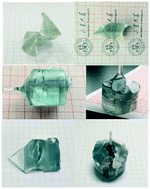A study on the technical improvement and the crystalline quality optimization of columnar β-Ga2O3 crystal growth by an EFG method
Abstract
High quality columnar β-Ga2O3 crystals were successfully grown via an edge-defined film-fed growth (EFG) method equipped with columnar Ir die. The effects of the pulling rate and die height on the structural quality and crystal shape of β-Ga2O3 are summarized and discussed in detail. The main problems of spiral and polycrystal formation and incomplete columnar quality in the β-Ga2O3 crystal growth were solved successfully. Suitable values for the growth parameters such as pulling rate and Ir height were determined to be in the range between 2–10 mm h−1 and 30–40 mm (0.6–0.8 mm longer than the crucible height), respectively. Simultaneously, the die diameter should be 25 mm (0.5 mm wider than the crucible diameter) to obtain columnar β-Ga2O3 crystals in good quality. Furthermore, the crystalline quality of the as-grown crystal was confirmed via high-resolution X-ray diffraction (HRXRD) with a full-width at half-maximum (FWHM) of 69.3 arcsec. The defects of β-Ga2O3 were studied via a chemical etching method. Two types of etch pits were observed: (1) a triangle-shaped etch pit and (2) a quadrangle-shaped etch pit. The average defect density was estimated at a lower order of magnitude of −104 cm−2.



 Please wait while we load your content...
Please wait while we load your content...